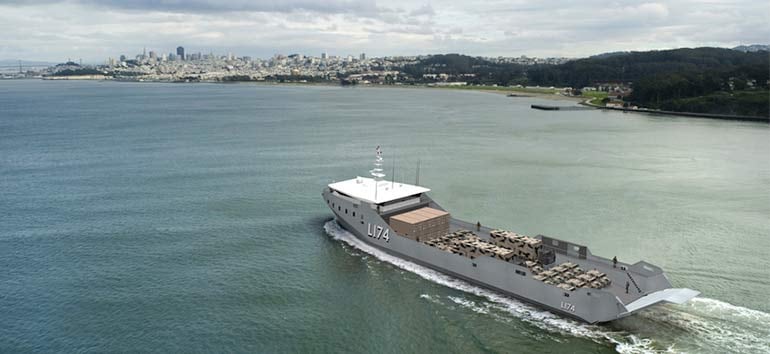WASHINGTON – The U.S. Navy is willing to pay more for new ships upfront if it means saving on maintenance and personnel costs throughout the life of the program, the head of amphibious, auxiliary and sealift programs told industry this week.
Tom Rivers, whose programs fall under the Program Executive Office for Ships, said “design for maintainability and flexibility” is one of the top focus areas for PEO Ships. He said it will influence how the Navy pursues several upcoming new programs, including the light amphibious warship (LAW), the next-generation logistics ship, a new submarine tender, a new ocean surveillance ship and the DDG(X) next-generation destroyer.
“LAW is a good example for the design for maintainability,” he said during a panel discussion at the Navy League’s annual Sea Air Space conference. “Having reliable equipment that does not require a lot of operator action to maintain will enable LAW to handle reduced manning, which, that’s the goal. It may require a larger upfront investment in higher-quality equipment, but we’re willing to do that to offset the sailor cost in the future.”
LAW is envisioned to have a crew of about 40 for the small ship that would haul about 75 Marines around remote areas as they hop from one temporary base to another.
Rivers added that LAW will include sensors and monitors enabling not only conditions-based maintenance, through which maintainers can see how well a system is running and conduct maintenance guided by performance data, but also remote condition-based maintenance. The small crew may not be the recipient of the data, but maintainers in regional hubs could receive the data remotely and help schedule maintenance periods into the ship’s operational plans.
Rivers said Team Ships is focused on leveraging data to a greater degree, to improve performance in both shipbuilding and ship maintenance. Both halves of Team Ships – PEO Ships on the construction side, SEA21 on the modernization side – have war rooms set up to track performance across the ship programs and take a more analytical approach to improving the enterprise.
Another top focus area for PEO Ships is on-time delivery of new-construction ships, an effort aided by this war room setup.
A third focus area is increased industry engagement, and Rivers said the LAW program is a good example of this as well. The Navy hosted multiple industry days and industry engagements for LAW, and Rivers said this will likely be the norm going forward, rather than hosting just a single industry day. He said it will also be important to engage lower-tier suppliers – especially if the Navy wants to see more reliable parts that support the condition-based maintenance concept.
The DDG(X) destroyer program office, which stood up in June, has already conducted early industry engagement to help develop the requirements for the ship, which will put the combat system and radar from the Flight III Arleigh Burke destroyer program on a new hull form with an integrated power system that can support larger and more power-hungry sensors and weapons into the future.
“We envision that DDGX will be the most capable surface combatant on the planet in the 2030s and all the decades to follow,” Rivers said. But to do that successfully, he added, the Navy and industry need to stay in lockstep about the ship’s design and development timeline.
Megan Eckstein is the naval warfare reporter at Defense News. She has covered military news since 2009, with a focus on U.S. Navy and Marine Corps operations, acquisition programs and budgets. She has reported from four geographic fleets and is happiest when she’s filing stories from a ship. Megan is a University of Maryland alumna.





